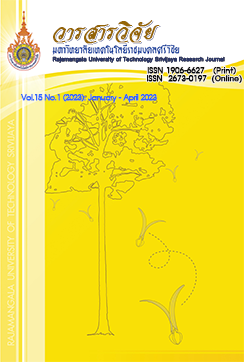The The Study of Gelling Agent and Sweeteners in Jelly Gummy from Toddy Palm Sugar
Keywords:
Gummy Jelly, Toddy Palm sugar, Gelling agent, SweetenerAbstract
The objectives of this research were to study types and quantities of gelling agents, type and quantity of sugar substitute sweeteners and their nutritional value in gummy jelly products made from toddy palm sugar. The gelatin content was studied at 5, 10 and 15% and sodium alginate was studied at 1 and 2% of total amount of ingredients. The results showed that the hardness and the chewing increased with the increase of gelatin content while the amount of gelling agent had no effect on springiness. The 9-point hedonic scale sensory acceptance test showed that the participants accepted a gummy jelly containing 10% gelatin and 1% sodium alginate. Study on the substitution of sweeteners, erythritol and maltitol, by substituting sucrose and sweetener were at a ratio of 100:0, 50:50 and 0: 100, respectively. The 9-point hedonic scale sensory acceptance test showed that the participants accepted gummy jellies using a 100:0 maltitol to sucrose ratio which could substitute maltitol for sucrose for 100%. The use of maltitol instead of sucrose in jelly gummy products increased the moisture content while the amount of ash, total carbohydrates and energy were reduced but there was no change in the protein content.
References
Aarstad, O., Heggset, E.B., Pedersen, I.S., Bjørnøy, S.H., Syverud, K. and Strand, B.L. 2017. Mechanical properties of composite hydrogels of alginate and cellulose nanofibrils. Polymer 378(9): 1-19.
AOAC. 2000. Official Methods of Analysis. 17th ed. Association of official analytical chemists, Gaithersburg, Md.
Chareekhot, K. 2016. Food analysis. Published document, Faculty of Technology, Udon Thani Rajabhat University. (in Thai)
Chedoloh, R. and Chemalee, S. 2019. Effect of Hydrocolloids on Quality and Stability of Halal Velvet Tamarind Jelly During Storage. RMUTT Journal, Science and Technology Issue 12(2): 62-74. (in Thai)
Choojun, S. 2012. Low-calorie sweeteners: biological production, properties and application. Chula press, Bangkok. (in Thai)
Dholvitayakhun, A., Chompoo, S. and Piwleuang, J. 2017. Development of passion fruit jelly mixed with gac fruit. Rajabhat Agriculture Journal 16(1):41-47. (in Thai)
Douglas, G.H. and Guo, Q. 2019. The role of hydrocolloids in the development of food structure, pp. 1-28. In Spyropoulos, F., Lazidis, A. and Norton, I., eds. Handbook of Food Structure Development. The Royal Society of Chemistry, Canada.
Glycemic index foundation. 2021. Hesed Palmyra Palm Sugar. GI Symbol. Available source: https://www.gisymbol.com/low-gi-products/hesed-palmyra-palm-sugar/, August 12, 2021. (in Thai)
Klin-ngarm, N. 2012. The lifestyle of the people of Phet city and the culture of rice, sugar, salt. Published document, Institute for the research and promotion of arts and cultures, Phetchaburi Rajabhat University. (in Thai)
Nilsart, K. 2014. Improving the temporal profile of artificial sweeteners. Master Thesis of Science Program in food technology, Silpakorn University. (in Thai)
Norsuwan, T. and Tantechai, S. 2019. Effect of maltitol on physical and chemical properties of low calorie passion fruit jam, pp. 863-870. In The 56th Kasetsart University Annual Conference. Kasetsart University. (in Thai)
Pornchalermphong, P. and Rattanapanon, N. 2012. Alginate. Food network solution. Available Source: http://www.foodnetworksolution.com/wiki/word/2568/alginate, August 12, 2021. (in Thai)
Ratmanee, P., Sihabandit, A., Homelakorn, S., Lelaikam, B., Phichai, S. and Phoratsor, W. 2017. Development of Ginger Gummy Jelly Products, pp. 629-633. In RMU GRC 2017: Academic conferences to present research results 2nd graduate degree. Rajabhat Mahasarakham University. (in Thai)
Ratthamma, P. and Phunkasem, A. 2019. Food science to innovation to reduce waste. Journal of The Department of Science Service 68(211): 33-35. (in Thai)
Rittilert, P. and Warin, K. 2020. Development of Karanda (Carissa carandas L.) Gummy Jelly Product. Thai Journal of Science and Technology 9(2): 343-354. (in Thai)
Srisangwan, N. 2012. Nutritional improvement of A-lua and Foi-thong desserts by using nonsugar sweeteners. Master Thesis of Science Food Technology Program Graduate school, Silpakorn University. (in Thai)
Suwan, T., Pradutprom, W., Ngamroop, W., Choosuk, N. and Phungamngoen, C. 2017. Development of Babbler’s Bill leaf gummy jelly. Burapha Science Journal 22(1): 198-201. (in Thai)
Teerawechcharoenchai, C., Jangchad, K., Jangchud, A., Harnsilawat, T. and Chariyachotilert, S. 2008. Effect of gelatin and glucose syrup on qualities of carrot sheet jelly, pp 303-310. In Proceedings of 52nd Kasetsart University Annual Conference: Agro-Industry. The Thailand Research Fund, Bangkok. (in Thai)
Thai community product standards. 2004. Thai community product standard (Soft Jelly). Available Source: http://tcps.tisi.go.th/pub/tcps519_47.pdf, March 15, 2020. (in Thai)
Thepphongsana, S. 2014. Coconut sugar, palm sugar. Available Source: https://www.si.mahidol.ac.th/sdc/webboard.com, March 15, 2020. (in Thai)
Thiensawai, A. and Kaeomanichai, A. 2013. Non-sugar Sweeteners in Thai Jelly Dessert. Available Source: http://herp-nru.psru.ac.th/
file/U55064_41.pdf, January 30, 2020. (in Thai)
Wongthong, O. and Phunphonkun, K. 2016. Cooking principles. Kasetsart University Press, Bangkok. (in Thai)
Worrasarn, N., Jaipakdee, N. and Limpongsa, E. 2018. Preparation and evaluation of gummy jelly products containing glucomannan, pp. 932-939. In The National and International Graduate Research Conference 2017. Khon Kaen University. (in Thai)
Downloads
Published
How to Cite
Issue
Section
License
Copyright (c) 2023 Rajamangala University of Technology Srivijaya Research Journal

This work is licensed under a Creative Commons Attribution-NonCommercial-NoDerivatives 4.0 International License.
The content and information in the article published in Journal of Rajamangala University of Technology Srivijaya It is the opinion and responsibility of the author of the article. The editorial journals do not need to agree. Or share any responsibility.







